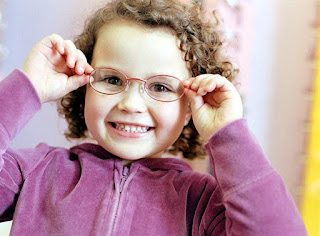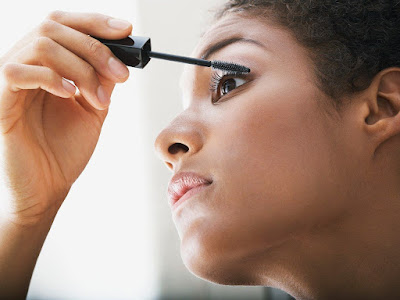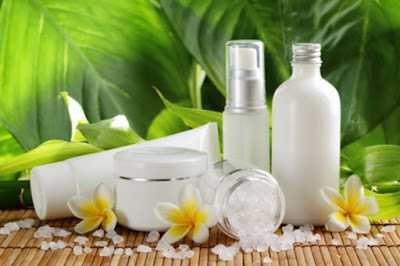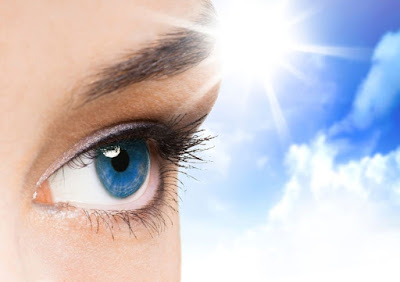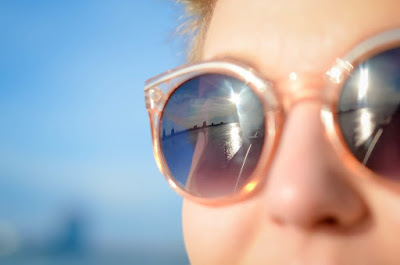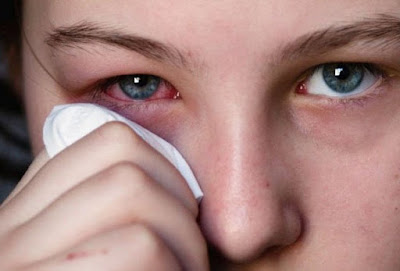Symptoms of dry eye: causes, treatment and prevention
 |
| What are dry eyes causes |
DRY EYE
The dry eye or dry eye syndrome (SOS) is a process that
affects many people still undiagnosed. It is estimated that more than 60% of
the population over 45 years of age suffer from this disorder. An ocular pathology that mainly affects women increasing with
age, up to 80% in those over 60 years.
What is dry eye?
The dry eye is an eye irregularity in which the eye produces
an insufficient amount of tears, very related to hormonal changes in the case
of women, as well as its poor quality or rapid evaporation, usually caused by
alterations in the glands of Meibomio (DGM).
These glands, which are found in the eyelids and secrete
lipids (fats), are responsible for lubricating the ocular surface and
preventing the tear film from evaporating, which is known as Meibomian Gland
Dysfunction (DGM).
Circumstances that affect the ocular surface composed of the
eyelids, the tear film, the conjunctiva and the cornea .
This lack or nonexistence of the tear in the eye is going to
be a problem since the tear is responsible for nourishing, humidifying and
lubricating the surface of the eye.
It is placed under the eyelids and works like the oil of a
machine so that the flicker passes smoothly over the eye without scratching or
damaging it.
Causes of dry eye syndrome
 |
| Causes of dry eye syndrome |
At present, dry eye is one of the most frequent causes or
reason for urgency more common in an ophthalmological service because of the
discomfort generated since it affects, according to the severity, the quality
of life of the patients who suffer it.
In this line, there are multiple factors that cause the
Meibomian Gland Dysfunction (DGM) of people suffering from dry eye, causing the
tear film to break and be exposed to air.
Therefore, it can influence its appearance in the following
scenarios:
- Alterations in the skin: acne
rosacea.
- Allergic disorders
- Rheumatic diseases:
antidepressants, antihistamines or contraceptives, among others.
- Hormonal changes: menopause.
- Addiction to tobacco.
- Having undergone previous eye
surgery, such as Lasik surgery, for the treatment of myopia , hyperopia and /
or astigmatism , since a decrease in the sensitivity of the cornea can occur.
- The abuse of contact lenses that
can even lead to a corneal ulcer .
- Read for long periods of time as the
frequency of blinking is reduced and the tear evaporates faster.
- Using an electronic device very
often can produce a greater lacrimal evaporation.
- Aging, especially after 50 years.
- Indoor environments (air
conditioning, heating systems) and outdoor environments (mainly arid climates
with low levels of humidity and wind)
- Take the plane a lot: the air in
the cabins of the plane is very dry.
- Some diseases such as diabetes,
lupus, rheumatoid arthritis or Sjorgren's syndrome can contribute to the
appearance of dry eye.
- Eyelid problems: such as
blepharitis , the inability to close the eyelid, a disease caused by aging or
after a blepharoplasty surgery , called lagophthalmos, can cause severe dry
eye.
- A laser eye operation or corneal
refractive surgery in general can also cause dry eyes.
Pollution also affects the dry eye
The high levels of air pollution are related to health
problems, mainly of the respiratory type. This high concentration of pollution
in the air, according to the World Health
Organization (WHO), contains particulate
matter, ozone, nitrogen dioxide and sulfur dioxide.
As a consequence, the lack of humidity and the increase of
air pollution, by the smoke of the cars and the chemical compounds of the
factories, contribute to a growth of ocular inflammations and the appearance of
the dry eye.
Symptoms of dry eye
Some of the symptoms that can indicate us to be before a
case of dry eye, in addition to ocular dryness, are:
- Burning: burning sensation
- Itching: itchy sensation in the
eyes.
- Redness
- Grit sensation.
- Upset when performing everyday
tasks such as reading, driving or fixing the look on a television screen, as
well as intolerance to contact lenses.
- You may also notice blurred vision
or excessive sensitivity to light.
- Heaviness in the eyelids.
- Photophobia (hypersensitivity to
light)
- Visual fatigue
- Tearful eyes, since the dryness of
the surface of the eye overstimulates the production of the aqueous component
of tears as a protection mechanism.
- Dry eye also causes inflammation
and pain.
It will be necessary to visit your ophthalmologist
immediately in the presence of these symptoms since their multifactorial origin
makes diagnosis and treatment difficult. Your ophthalmologist should therefore
perform a proper examination to determine the causes of your symptoms and the
evolutive state of your dry eye.
Diagnosis of dry eye
Until now, the diagnosis of dry eye was relatively complex
since there was no diagnostic test to help the detection, identification and
measurement of the severity of this annoying pathology.
Until then, some tests that were performed in the
ophthalmology consultations were the
ocular surface staining with fluorescein , for a more detailed
visualization of the cornea, as well as to see the presence or not of possible
corneal ulcers. A Schirmer Test has also been used , consisting of placing small strips of filter
paper in the lower eyelids of both eyes in order to quantify the patient's
production of tears.
At Oftalvist we have acquired an advanced technology called
DX Analyzer to make a qualitative leap in diagnostic matters and obtain better
control, monitoring and prevention of dry eye.
DX Analyzer
DX Analyzer is a useful, effective and highly accurate tool
for the analysis of the quality of the tear film that offers us important data
to know the objective changes of the tear film and the visual quality of the
patient at every moment.
Thanks to this information, the specialist ophthalmologist
will be able to evaluate the best therapeutic treatment to apply to the
patient.
OSDI test
The OSDI test is used to establish the type of severity and
classification of the dry eye according to its symptomatology. It gives us a
clue as to the type of dry eye the patient has, as well as the treatment.
Download the following PDF to perform the test and check the
box that best suits your situation. You will get a score that classifies your
dry eye into normal, mild / moderate or moderate / severe.
Dry eye treatment
As it is generally a chronic and progressive ocular
pathology, the treatment until now used to be long term .
Artificial tears
The most widespread classical treatment was the application
of artificial tears without preservatives to help maintain moisture. Composed
of water, they are an isotonic or hypotonic saline solution that helps to
prolong the permanence of artificial tears on the ocular surface, in addition
to preventing any contamination, as well as preventing any type of ocular
irritation.
Topical cyclosporine
In more complex cases, eye drops have been used with growth factors obtained from the
patient's own serum and immunosuppressive drugs to fight inflammation, such as
cyclosporin A.
Probing of the Meibomian glands
It is a non-invasive surgical procedure that aims to open
the outlet of the Meibomian glands, extract the fat content from inside and
apply an antibiotic to normalize the microbial flora. It is done with
superficial sedation and is painless.
Exfoliation of the free edge of the eyelids and glandular
drainage
It is one of the least invasive techniques. It is about
removing the membrane that clogs the Meibomian glands through an exfoliation.
Next, a massage is performed to empty the contents of the glands applying cold
and antioxidants to reduce the inflammation of the eyelids and improve
lymphatic drainage.
Other treatments
 |
| Dry Eye treatment |
Other treatments that have been used, guided only by an
ophthalmologist are: topical corticosteroids, sodium hyaluronate, autologous
serum tears, pilocarpine (in patients with Sjögren's syndrome) or hyaluronic
acid in combination with other products such as xanthan gum or the HP-guar,
among others.
Pulsed light treatment for dry eyes
In addition to the procedures mentioned, in the Ophthalmist Dry Eye Unit we have taken the step towards new pulsed light technologies that offer much more truthful and useful data
to establish a more effective and safe lasting treatment.
For this reason we have two advanced non-invasive and
painless high-frequency pulsed light laser technologies ( ThermaEye and Ellipse
) that serve to stimulate Meibomian glands without the need to enter the operating
room. The pulsed light helps to stimulate circulation and acts on the nerve
endings in order to control the production and secretion of fats improving the
visual quality of the patient with excellent results.
For more information about our procedure for the treatment
of pulsed light click here.
Prevention of dry eye
People most susceptible to dry eye can find relief by
incorporating omega-3 fatty acids into their diets that can be found in foods
such as blue fish , salmon, sardines, tuna, mackerel or trout, as well as seafood , like the crab, the prawns or the
mussels.
Vegetable foods such
as flax seeds or chia seeds are also recommended , as well as nuts such
as nuts and drinking lots of liquid.
Recent studies affirm that diets low in omega-3 and
antioxidants, but rich in omega-6 produce an oxidative stress that generates
inflammatory effects on the meibomian glands, the cornea and the conjunctiva.
In addition, it is also recommended to be away from dry environments , air currents , smoke snuff
and air conditioners that can irritate our eyes because they promote the
evaporation of the tear. It is also advisable to use a humidifier and even
protective sunglasses every winter during the year.
On the other hand, it is convenient to blink frequently,
clean the eyelashes (where the lacrimal glands are) with warm compresses or put
on artificial tears from time to time to compensate for the lack of natural
tears.



